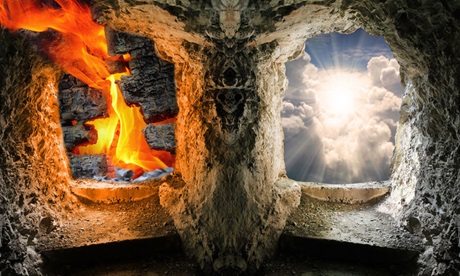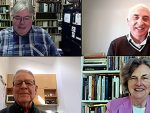Taken as a whole, the online Catholic world can look more like an abstract pointillist painting than a coherent landscape. To borrow the imagery of Isaiah Berlin, the internet environment encourages us to think like foxes rather than hedgehogs.
Virtual discussions roam over many small things (e.g., the kerfuffle last spring over Harrison Butker’s graduation address at Benedictine College), rather than one or two big things.
And there is no bigger question for Catholics today than this: Why should anyone become or remain Catholic?
Pre- Second Vatican Council
Before the Second Vatican Council, the answers commonly given to this question focused on individual well-being in the afterlife. As many Catholic characters in movies and novels attested, a basic reason to be Catholic was “so I won’t go to hell.”
The Catholic faith, in their view, is the best guarantee that they will not spend eternity suffering the excruciating flames of eternal torment. Instead, they will enjoy heavenly paradise.
Catholic teachings provide a roadmap of the best route to heaven, and the sacrament of penance was a sure way to correct course if you lose your way.
This position is easily caricatured in several ways.
First, heaven and hell are often depicted as destinations external to the soul, corresponding to external rewards and punishments. The soul is the same soul in heaven or hell—but it is happy in the former and miserable in the latter.
Second, sacraments and other religious devotions are portrayed as external sources of energy that are used by the soul, but do not change its fundamental character.
I go to Mass on Sundays in order to fill up my spiritual gas tank, so that I can drive my soul-car to heaven. But it is still the same old me that is driving the soul-car.
Third, the system is presented as both predictable and arbitrary. Suppose I commit a mortal sin on Friday and intend to go to confession on Saturday. If I am hit by a car leaving church on Saturday, I go to heaven. If I am hit by a car walking into church, I go to hell.
The sacramental system is depicted as an elaborate set of machinery, almost a soteriological Rube Goldberg machine. The rules are clear, even if they are not always fair.
The actual theology, however, has always been far richer than the caricatures.
Catholic theologians would say that the process of moral living itself transforms you, because it is an encounter with God’s grace. You adopt good habits out of fear and obedience.
Then you begin to see the holiness and beauty of God, and you continue those habits, which gradually allow you to love God and want to live in God’s presence in eternity.
A famous question in The Baltimore Catechism asks “Why did God make you?” The answer is that “God made me to know Him, to love Him, and to serve Him in this world, and to be happy with Him forever in the next.”
Heaven and hell
After Vatican II, however, the more individually oriented account of the reasons to be Catholic began to be supplemented—if not supplanted—by a different view that approached questions of salvation in a somewhat different way.
One difference was the reduced emphasis on the details of eternal punishment.
With the advent of mass media creating widespread exposure to the atrocities of war, people in the 20th century understood well the horrors of torture and suffering.
Theologians and ordinary believers alike began to question the depictions of hell found in poets like Dante and lesser writers.
How anyone with a shred of compassion could subject any creature to torture or torment, much less eternally, was beyond the grasp of many both morally and existentially.
For a divine, omnipotent being to inflict such pain on any sentient creature is monstrous; such a god might reasonably be placated, but would never be worthy of worship.
Consequently, the God who became fully human in Jesus Christ could never behave in such a fashion.
Even the more sophisticated notion of hell, as a state of the soul entirely separated from God, love, truth and light for all eternity, began to seem morally and existentially problematic.
How could a good God, who sent His only begotten Son to save us, who pursued every lost sheep, allow any of his creatures to be definitively lost?
On a more terrestrial plane, it could sometimes seem that the defenders of hell were (like Dante) too inclined to populate it with their own enemies, while reserving heaven for themselves and their friends.
Pope Francis recently critiqued this danger when he wrote that heaven is for everyone (“tutti, tutti, tutti”) and warns against imagining it as a gated community for self-proclaimed upright souls.
Building the kingdom
After Vatican II, however, the chasm between heaven and hell receded from both academic theology and the popular imagination. The post-Vatican II worldview did not so much bridge the chasm as sidestep it, by reframing the issue.
Drawing upon the council’s “Dogmatic Constitution on the Church” (“Lumen Gentium”) and the “Pastoral Constitution on the Church in the Modern World” (“Gaudium et Spes”), many Catholics envisioned their predominant duty to be helping to build the kingdom of God.
This kingdom of God is already in our midst, inaugurated by the death and resurrection of Jesus Christ, but it is not yet fully complete. With the grace of Christ, who is the cornerstone, our task is to cooperate with other Christians and all people of good will in bringing it to fruition.
The focus on building the kingdom of God displaces the heaven-hell chasm in two ways. Read more
- M. Cathleen Kaveny is the Darald and Juliet Libby Professor of Law and Theology at Boston College.
News category: Analysis and Comment.




